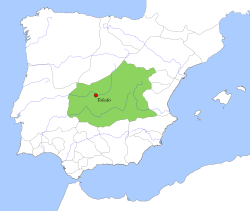
Back طائفة طليطلة Arabic Taifa Toledo Breton Emirat de Tulàytula Catalan Tajfo de Toledo Esperanto Taifa de Toledo Spanish Toledoko taifa Basque Taïfa de Tolède French Toledska Taifa Croatian Taifa di Toledo Italian トレド王国 Japanese
Taifa of Toledo | |||||||||
|---|---|---|---|---|---|---|---|---|---|
| 1018 (de facto)–1085 | |||||||||
 Taifa Kingdom of Toledo, c. 1037. | |||||||||
| Capital | Toledo | ||||||||
| Common languages | Arabic[1] | ||||||||
| Religion | Islam, Christianity (Mozarabic Rite), Judaism | ||||||||
| Government | Monarchy | ||||||||
| Emir | |||||||||
• c. 1036–1043 | Ismail al-Zahir | ||||||||
• 1043–1075 | Yahya I al-Ma'mun | ||||||||
• 1075–1085 | Yahya al-Qadir | ||||||||
| Historical era | Middle Ages | ||||||||
• Established | 1018 (de facto) | ||||||||
• incorporated to the taifa of Badajoz | 1080–1081 | ||||||||
• Disestablished | 1085 | ||||||||
| Currency | Dirham and Dinar | ||||||||
| |||||||||
| Today part of | Spain | ||||||||
The Taifa of Toledo (Arabic: طائفة طليطلة) was an islamic polity (taifa) located in the centre of the Iberian Peninsula in the high middle ages. It was ruled by the Dhulnunids, a Hawwara Berber clan. It emerged after 1018 upon the fracturing of the Caliphate of Córdoba, when the Dhulnunids, already strong in the lands of Santaver, Cuenca, Huete and Uclés, seized control over the city of Toledo, the capital of the Middle March of Al-Andalus.[2] Upon later territorial conquest, the taifa also expanded to the land of Calatrava.[3] It lasted until the Christian conquest of Toledo in 1085.
- ^ Zwartjes, Otto (2006). "Andalus". In Versteegh, Kees (ed.). Encyclopedia of Arabic Language and Linguistics. Brill Academic Publisher. p. 58.
- ^ Izquierdo Benito, Ricardo (1986). Alfonso VI y la toma de Toledo (PDF). Diputación Provincial de Toledo. p. 14. ISBN 84-00-06167-5.
- ^ Urquiaga Cela, David (1997). "Aproximación al estudio del poblamiento en época andalusí en el valle medio oriental del Tajo". In Lorenzo, J. (ed.). Organización social del espacio en el Madrid medieval (PDF). Vol. II. Madrid. p. 21. ISBN 84-87090-17-6.
{{cite book}}: CS1 maint: location missing publisher (link)